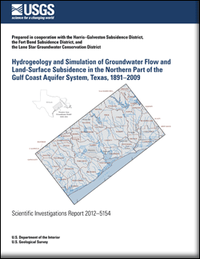Hydrogeology and simulation of groundwater flow and land-surface subsidence in the northern part of the Gulf Coast aquifer system, Texas, 1891-2009
Links
- More information: USGS Index Page (html)
- Document: Report (pdf)
- Download citation as: RIS | Dublin Core
Abstract
In cooperation with the Harris–Galveston Subsidence District, Fort Bend Subsidence District, and Lone Star Groundwater Conservation District, the U.S. Geological Survey developed and calibrated the Houston Area Groundwater Model (HAGM), which simulates groundwater flow and land-surface subsidence in the northern part of the Gulf Coast aquifer system in Texas from predevelopment (before 1891) through 2009. Withdrawal of groundwater since development of the aquifer system has resulted in potentiometric surface (hydraulic head, or head) declines in the Gulf Coast aquifer system and land-surface subsidence (primarily in the Houston area) from depressurization and compaction of clay layers interbedded in the aquifer sediments.
The MODFLOW-2000 groundwater flow model described in this report comprises four layers, one for each of the hydrogeologic units of the aquifer system except the Catahoula confining system, the assumed no-flow base of the system. The HAGM is composed of 137 rows and 245 columns of 1-square-mile grid cells with lateral no-flow boundaries at the extent of each hydrogeologic unit to the northwest, at groundwater divides associated with large rivers to the southwest and northeast, and at the downdip limit of freshwater to the southeast. The model was calibrated within the specified criteria by using trial-and-error adjustment of selected model-input data in a series of transient simulations until the model output (potentiometric surfaces, land-surface subsidence, and selected water-budget components) acceptably reproduced field measured (or estimated) aquifer responses including water level and subsidence. The HAGM-simulated subsidence generally compared well to 26 Predictions Relating Effective Stress to Subsidence (PRESS) models in Harris, Galveston, and Fort Bend Counties. Simulated HAGM results indicate that as much as 10 feet (ft) of subsidence has occurred in southeastern Harris County. Measured subsidence and model results indicate that a larger geographic area encompassing this area of maximum subsidence and much of central to southeastern Harris County has subsided at least 6 ft. For the western part of the study area, the HAGM simulated as much as 3 ft of subsidence in Wharton, Jackson, and Matagorda Counties. For the eastern part of the study area, the HAGM simulated as much as 3 ft of subsidence at the boundary of Hardin and Jasper Counties. Additionally, in the southeastern part of the study area in Orange County, the HAGM simulated as much as 3 ft of subsidence. Measured subsidence for these areas in the western and eastern parts of the HAGM has not been documented.
Study Area
| Publication type | Report |
|---|---|
| Publication Subtype | USGS Numbered Series |
| Title | Hydrogeology and simulation of groundwater flow and land-surface subsidence in the northern part of the Gulf Coast aquifer system, Texas, 1891-2009 |
| Series title | Scientific Investigations Report |
| Series number | 2012-5154 |
| DOI | 10.3133/sir20125154 |
| Edition | Originally posted July 31, 2012; Revised December 2, 2013 |
| Year Published | 2012 |
| Language | English |
| Publisher | U.S. Geological Survey |
| Publisher location | Reston, VA |
| Contributing office(s) | Texas Water Science Center |
| Description | ix, 55 p. |
| Country | United States |
| State | Texas |
| Other Geospatial | Gulf Coast Aquifer System |
| Online Only (Y/N) | Y |
| Additional Online Files (Y/N) | N |


